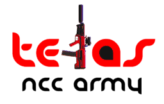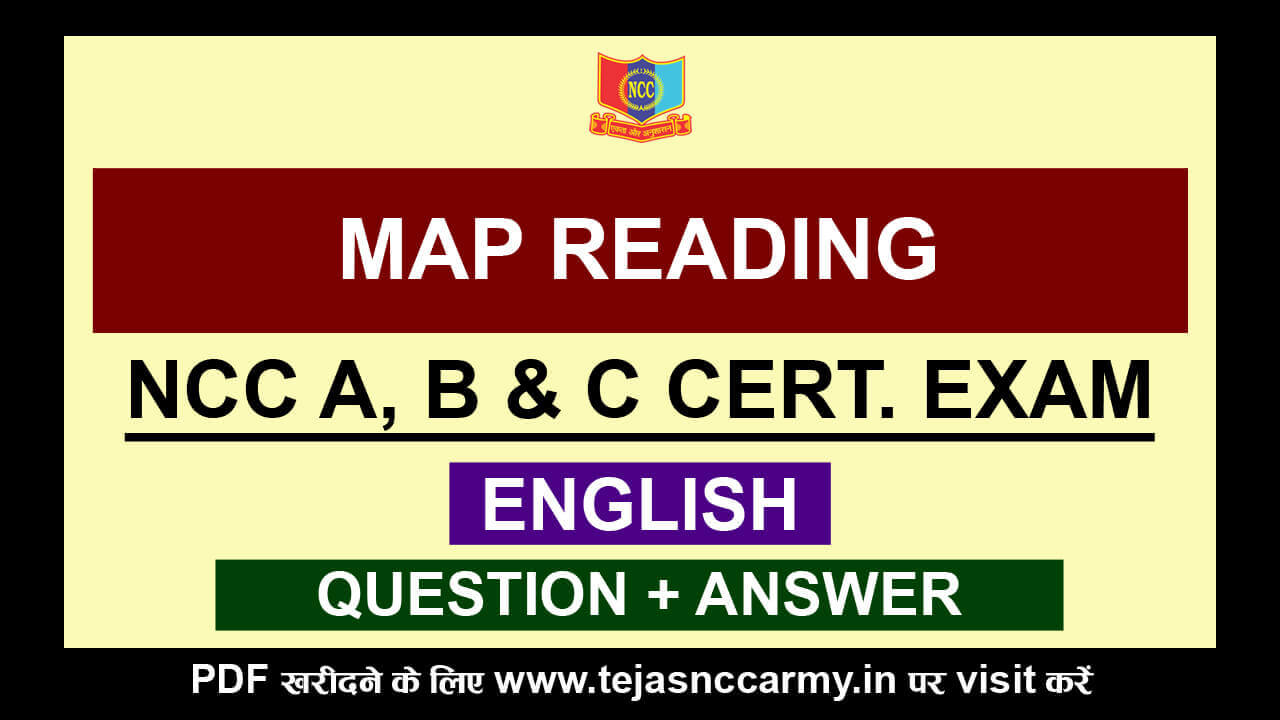1. What is a map called ?
Ans :- The picture made of paper, cloth or cardboard on which definite part of the earth on a certain scale by symbols displays or maps It is called.
2. State the types of maps ?
Ans :- 7 types :-
(i) Geomorphic Map (ii) Geographical Map
(iii) Political Map (iv) Historical Map
(v) Statistical Map (vi) Economic Map
(vii) Military Map
3. Write different types of North :-
Ans :-
(i) True North (ii) Magnetic North (iii) Grid North
4. Name the 10 parts of compass.
Ans :-
(i) Tongue (ii) Tongue Notch (iii) Glass window
(iv) Glass protector (v) Hair line (vi) Lead
(vii) Luber Line (viii) setting vane (ix) clamping screw
(x) Arrow Head (xi) Dial (xii) Rotary Glass
(xiii) Eye Hole (xiv) Thumb Ring (xv) Ring Notch
(xvi) Direction Mark
5. Fill in the blanks :-
(i) Bearing on the map through _______ Is measured .
Ans :- Service Protector
(ii) The R.F of the meter map used is _______.
Ans :- 1/50,000
(iii) Pink/white running vertical and horizontal on the map Red lines are ________ lines.
Ans :- Grid
(iv) Correct answer without compass at night through _____ can be found from.
Ans :- Pole Star 🌟
(v) Cultivable land is shown on the map in _________.
Ans :- Yellow Color
(vi) If the bearing is 30 degree then the back bearing is _______.
Ans :- 210°
(vii) An isolated hill is called ________.
Ans :- Knoll
(viii) Height on the map through brown lines It is shown which is called _____.
Ans :- Countout Line
(ix) Distance on a map is measured through _______.
Ans :- Service Protractor
(x) The top part of the hill is Called _____ .
Ans :- Peak
(xi) The difference between true north and magnetic north is __________.
Ans :- M.V ( Magnetic Variation )
6. Write the different functions of Compass ?
Ans :-
(i) in measuring degrees (ii) Route in March
(iii) in map reading (iv) Finding Own Position
(v) In finding the direction
7. Write the usage of Service Protector ?
Ans :-
(i) Finding Own Position (ii) to calculate GR
(iii) Finding the distance on the map (iv) Scale work
8. What are the benefits of reading a Map ?
Or
What information can you get from the Map ?
Ans :-
(i) Finding your position
(ii) Finding the enemy’s position and distance
(iii) without visiting any object its geographical position detection
(iv) Getting information about any locality
(v) forward and backward degree of any place Find out
(vi) Can know the different nature of the land
(vii) choose the proper path to merge
(viii) can plan the activities of two places mutually visible especially during the time of war
9. What is Global Positioning System ( GPS ) ?
Ans :- It is a system of satellites and receiving instruments which people and equipment their presence on earth provides accurate information about general 24 satellites used in GPS operating system Which completes the orbit of the earth in 12 hours Huh .
10. How to find the north direction in night and day ?
Ans :-
Day night
(i) by wires (i) clock method
(ii) Idgah (ii) Surya Vidhi
(iii) Masjid (iii) By the leaves of the tree
(iv) by GPS
(v) by compass
11. Draw traditional sign/weapon sign :-
(a) Temple –

(b) Idgah –

(c) Fort –

(d) Church –

(e) electric wire –

(f) Mosque –

(g) LMG –

(h) MMG –

(i) HMG –

(j) 51 inch motor –

Answer :- ( You will remember the answer of all these from the book or ask your PI Staff )
12. Make Military Signs :-
(a) Survey Tree –

(b) Bridge –

(c) Battalion Headquarters –

(d) Infantry Platoon –

13. What is the composition of the Navigation Party ?
Ans :- The structure is as follows –
(i) Guide – It is carried with a bright stick and set compass leads the way
(ii) Auxiliary guide – It is done by tying white cloth on the back. Measuring the depth of pit and drain to another place with a stick walks
(iii) Recorder – This is another compass and pebble in pocket Whom it takes to measure the distance uses
(iv) Scouts – Scouts follow behind Number of works to be done in route ranges from 2 to 4 according to
14. Optional Questions :-
(i) To what degree can the compass be read ?
Ans :- 0° to 360°
(ii) PO stands for ?
Ans :- Post Office
(iii) What does LG mean ?
Ans :- Landing Ground
(iv) Which color is used to represent the road on the Map is used ?
Ans :- Red colour
15. State the drawbacks of the map :-
Ans :-
(i) No map can be up to date
(ii) Map is made by taking a scale on paper Therefore, it is impossible to see all the guests of the land. Not there .
16. What is Navigation Party ? By Navigation party Write the items used ?
Ans :- Navigation party is a small group, in which There are mainly three persons. this party is big From a place showing the way to big parties Takes it to another place and brings it back. this Many to reach the goal passes through the border.
Goods used by the Navigation Party :-
(i) Different Compass set up
(ii) glow stick
(iii) White Fabric or Shining Plywood
(iv) Different marching torches
(v) Pebble stone or rope
(vi) Blacked out torch
(vii) Black blanket
(viii) stick for measuring the pit
17. Define the following :-
Easting Line :- The vertical line on the map of which The serial number should be from left to right.
Northing Line :- The line lying on the map ( Horizontal line ) whose serial number from bottom to top
18. Use of different colors on the map :-
(i) Green color – for vegetation
(ii) Black/Red color – for man made things
(iii) Blue color – for water figures
(iv) Brown color – for surface figures
(v) Yellow color – for agricultural land
19. Define the following :-
(a) Service Protractor :- Is a rectangular instrument made of ivory, plastic, wood or belt, etc., which is mainly used to draw and measure the scale on the map. It is 6 inches long and 2 inches wide. At present, there is more circulation of Income Tax Service Protector Mark-lll A and Mark-4 A in the army.
(b) Romer :- Romer is a card made of plastic / cellulite or carton, on both sides of the right angled corner, the length of the side of the grid square is divided into 10 equal parts and marks are marked. Whose number starts from the right angled corner where the end of the arrow is marked.
(c) Prismatic compass :- It is a round bibiano my differential whose needle always points towards magnetic north. There are two types, dry and liquid army mainly uses liquid prismatic compass whose full name is
20. How to set up the map, write in detail ?
Answer :- First of all put down the map and lift the compass and draw his hairline on the black line of the map Keep straight and slowly turn the map to your right Rotate until the black line on the map hairline and compass needle which is the real answer shows that when all three of these do not come in a straight line If you come in a straight line, then understand that your map set done . Straight talk TN, MN and GN into one Doing it in a straight line is called a Map set.
21. How to calculate 4 Figure and 6 Figure ?
Ans :-
(i) 4 Figure = no. of Column + no. of Row
(ii) 6 Figure = no of Column & no of line left to right + no of Row & no of line down to up
22. Write the full name of the following :-
(i) Compass :- Liquid Prismatic Compass Mark-lll A
(ii) Service Protector :- Service Protector A Mark-llll
(iii) GPS :- Global Positioning System
23. What is the length and width of the Service protector ?
Ans :- Length = 6″ width = 2″
24. Which line number is first while calculating GR is taken ?
Ans :- Easting Line
25. To what degree can we forgive by hand ?
Ans :- Up to 19°
26. Which chart should be used for marching at night use ?
Ans :- Night March Chart
27. What is called Dead Ground ?
Ans :- To the ground buried between the target and the viewer
Best Of Luck
Jai Hind


Good material
thanks
ℍ𝕠𝕨 𝕔𝕒𝕟 𝕚 𝕕𝕠𝕨𝕟𝕝𝕠𝕒𝕕 𝕡𝕕𝕗